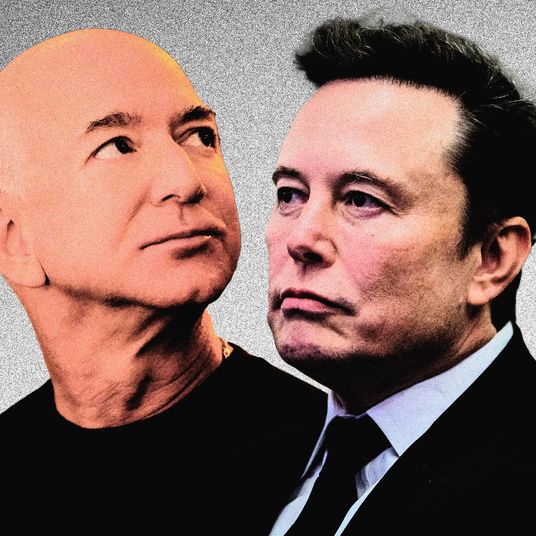
Last year, Trump Media & Technology Group lost $58.2 million on $4.1 million in revenue. In March, it went public under the symbol DJT, and today its stock is trading at a price that values the company at more than $5 billion. It’s an absurd financial story that is nonetheless easy to comprehend. Owning DJT stock is a way to signal support for the man, invest in the enthusiasm of others, and to indirectly give him money — Donald Trump owns a substantial chunk of the firm. It’s an “ethical nightmare” by design, a brazen rearticulation of public corruption in the language of finance, and a sneering refutation of generations of messaging about the purpose and function of public markets.
Most coverage of Trump Media & Technology Group hasn’t spent much time on the company’s actual product, the social-media platform Truth Social, because it’s materially irrelevant and basically self-explanatory: Trump built Truth Social after he was banned from mainstream social platforms after he incited January 6. It’s been around for a couple of years and hasn’t amounted to much; the only content on the platform that breaks through to the outside world are posts from Trump, which are by far the most popular on the site. Other right-leaning “alt-social” sites have mostly failed, and those that remain have been rendered obsolete by Twitter’s transformation into X, which has become the de facto home of the online right. In cultural and political terms, nothing much starts on Truth Social, and it can’t make anything go viral, mainly because it’s so small. The New Yorker recently described it as a “Potemkin village” and compared the experience of using the site to attending a shoddy Republican carnival. A critic at the Los Angeles Times likened it to a “town hall in a ventless conference room, where an endless line of folks step up to the mic to share how the world is out to get them” as well as, more darkly, a place where “madness and misinformation [go] largely uncontested.”
This is all true as far as it goes, but there’s something else going on here, too, among the small number of people who appear to be using Truth Social authentically. Truth Social isn’t just an also-ran Twitter clone. It’s a throwback — a nostalgic reconstruction of what social media was like for Trump supporters from before Trump was president. It is, in its modest way, an online mini MAGA campaign, promising a core of faithful posters a return to an internet that has been ruined twice over: first by the meddling libs who run Facebook and Instagram but more recently by fellow online conservatives, who have become — even by the high standards set during the Trump years — pretty fucking weird.
Trump is by far the most popular poster on Truth Social, to the point that the site is basically structured around his frequent posts. His replies are one of the only places other posters can reliably be seen, and they can be seen posting predictable things in response to “Truths” that are written in late Trump style (Truth Social has a 1,000-character limit):
All of the competitors to TRUTH SOCIAL, especially those in the Radical Left Democrats Party who are failing at every level, like to use their vaunted “disinformation machine” to try and convince people, and it is not easy to do, that TRUTH is not such a big deal and doesn’t “get the word out” as well as various others, which they know to be false. I THINK TRUTH IS AMAZING! First of all, it is very solid, having over $200,000,000 in CASH and ZERO DEBT. More importantly, it is the primary way I get the word out and, for better or worse, people want to hear what I have to say, perhaps, according to experts, more than anyone else in the World. My TV ratings are by far the highest, and my Rallies are not equaled, even close, anywhere or by anyone. Look, I had hundreds of millions of followers on various platforms, and could have them back again, but was cancelled for largely political reasons. Those platforms all want me back…They need me back! On Truth I have 7,000,000 followers……
The first clue that Truth Social is a bit different, though, is in how things look in the replies. Truth Social supports videos, but most users don’t post them. Unlike other social networks — which have been crammed full of video in an effort to compete with TikTok — Truth Social feeds are static, creating something like a sensory sanctuary. A huge number of the posts are just image memes that look like this:
This is a classic format, of course: top text, bottom text, Impact font. Image macros styled like this have been circulating for nearly 20 years, and you still occasionally encounter them in the wild. They’re also unmistakably retro. In 2015, these kinds of posts were some of the most viral political content on Facebook, where Trump supporters subscribed to thousands of wildly popular new political Pages largely out of view of the political press and even most other platform users. Even then, their content felt as if it were from a different era, inflected with both the aesthetics and paranoid ideology of fwd:fwd:fwd email chain letters from decades past.
Some of the more generic image macros you encounter on Truth Social have been fried to a crisp by years of sharing and copying across platforms. Others scan as vintage shitpics while containing recent references, resulting in uncanny anachronism. Whoever might be making and posting these memes — dedicated MAGA aunts, bored foreign-intelligence officers, Trump-adjacent political professionals, spammers — is doing so with an eye on the past, recalling a time when, for Trump’s online supporters, posting about politics felt new and exciting and when the candidate himself was more of an idea than a man with an actual legacy. Its trending topics, which appear to be curated, read like a MAGA table of contents:
Trump’s own feed is full of grievances and reposted conspiracy theories that won’t be entirely legible to people who don’t spend a lot of time around right-wing communities online, or watch much Fox News, but in MAGA terms, the site is familiar bordering on mundane. It really does feel like a big right-wing Facebook group ca. 2016, back before the company de-prioritized political content, restored for consumption in 2024. It’s also a platform run by the presumptive Republican nominee, largely for the benefit of the presumptive Republican nominee, and its users’ meager output aligns with those priorities.
Truth Social has also fallen somewhat out of alignment with the online right, which has developed and gathered elsewhere, most recently on X, where Elon Musk has courted, humored, and amplified a new coalition of reactionary posters and activists — at the same time displacing Trump as the main character on the platform. This strange mix of moral-panic systematizers, esoteric “traditionalists,” technofascists, and racist 4chan trolls represents a small number of actual people but dominates conservative discourse online. The online right is by no means against Trump — everyone is moving in the same direction here — but it emerged from a social-media environment in which Trump had been sidelined and to which he hasn’t fully returned.
I don’t want to overstate the importance of a few thousand people on X or of Trump’s minuscule social-media platform. But the fuzzy, Trump-centric nostalgia of Truth Social does hint at tensions within the online conservative movement that could become more apparent when the presidential campaign begins in earnest, between — and I’m only sort of kidding here — lockstep reply guys who love Donald Trump and shrill reply guys who prefer Elon Musk (an earlier and less pronounced version of this hyperonline reaction versus MAGA dynamic arguably sank the DeSantis campaign and was a drag on Republicans in the 2022 midterms).
Truth Social represents a return to the online past, a mini MAGA within MAGA, a wish to restore the internet that Trump and his campaign want, the one they believe helped them win in 2016.

































